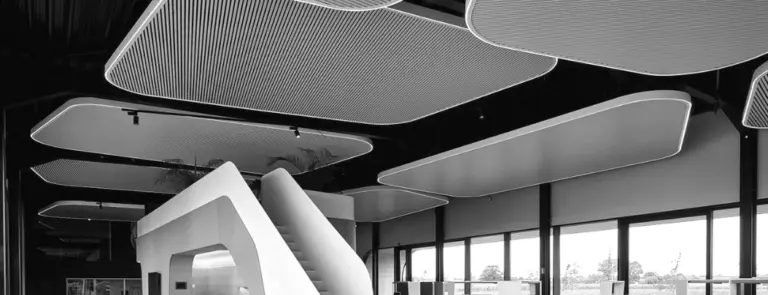
Climate ceiling: The sustainable alternative for comfortable spaces
Nowadays, people and companies want to find ways to reduce their impact on the environment. This is because they are paying more attention to sustainability and energy efficiency. An emerging choice is the climate controlled ceiling or cooling ceiling, which, in addition to comfort, also helps reduce energy consumption. We look at the benefits of cooling ceilings and why they are increasingly seen as the best option for sustainable buildings.
An exciting project is the heat network in Roeselare, which provides environmentally friendly heat to several buildings. We look at how Roeselare wants to greatly reduce CO2 and expand the heat network. Goddeeris is also contributing to a sustainable Roeselare by connecting organizations to the heat network.
What are climate ceilings?
They are an innovative heating and cooling system integrated into the ceiling. Unlike old-fashioned heating systems that distribute warm air through radiators, climate ceilings work on the basis of radiant heat. Here, heat or cooling is delivered directly to the room through water circulation in the ceiling tiles. This ensures an even and comfortable temperature in the rooms
Energy efficiency and sustainability
One of their main advantages is their energy efficiency. Because they use radiant heat instead of air circulation, energy costs can be saved significantly.
Furthermore, climate ceilings can cooperate with environmentally friendly energy sources such as heat pumps or solar panels, resulting in reduced energy consumption.
In addition, they contribute to a healthier indoor environment. They prevent the circulation of dust, allergens and pollutants, resulting in better air quality. This is very beneficial for people with allergies or respiratory problems. Using climate ceilings also reduces the risk of moisture and mold, creating a healthier living environment.
Flexibility and aesthetics of a climate ceiling
Climate ceilings also offer great flexibility in terms of design and aesthetics. They can be seamlessly integrated into different types of ceilings and can be customized to meet the specific needs of a room. Climate ceilings are available in different materials, finishes and colors, making them both functional and visually appealing. with renewable energy sources, such as heat pumps or solar panels, further reducing energy consumption.
In addition, climate ceilings contribute to a healthier indoor environment. They prevent the circulation of dust, allergens and pollutants, resulting in better air quality. This is especially beneficial for people with allergies or respiratory problems. In addition, climate ceilings reduce the risk of condensation and mold growth, contributing to a healthier living environment.
Noise reduction and comfort of a chilled ceiling
Another benefit of air-conditioned ceilings is their ability to reduce noise pollution. Because the heating and cooling are in the ceiling, they reduce annoying noises that are common with ordinary HVAC systems. This creates a peaceful and comfortable atmosphere, perfect for locations such as offices, schools, hospitals and other places where silence is important.
Long-term cost savings
Although climate ceilings can be more expensive to set up than traditional systems, the long-term operating costs are much lower. The energy savings, longer life and reduced maintenance requirements all contribute to the overall cost savings.
In addition, a climate ceiling can help achieve certifications such as LEED and BREEAM, giving building owners access to financial benefits and grants.
Climate ceilings are comfortable and beautiful in buildings, as well as contributing to sustainability. With their energy efficiency, healthy air, flexibility and cost savings, climate ceilings are ideal for new and existing buildings. If you’re looking for a green HVAC solution that improves comfort and well-being, climate ceilings are a smart choice.




